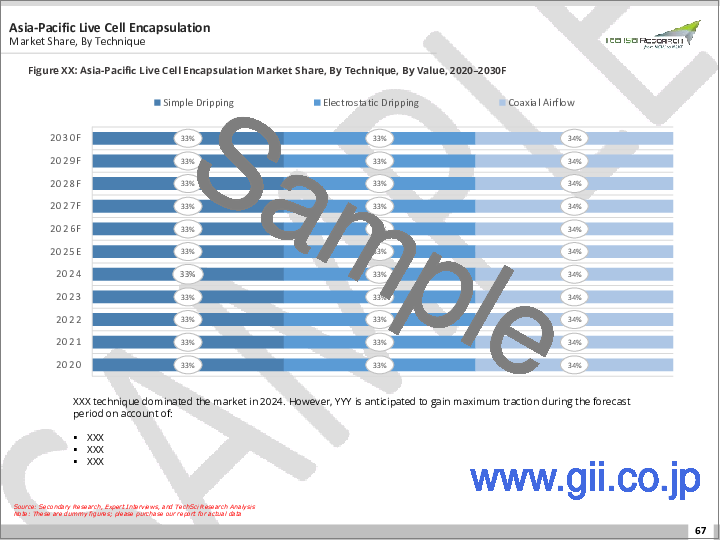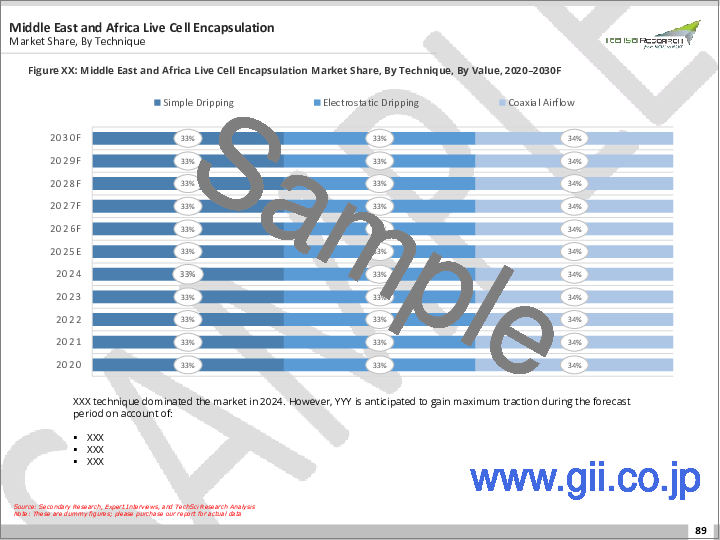|
|
市場調査レポート
商品コード
1778987
生細胞カプセル化市場 - 世界の産業規模、シェア、動向、競合、機会、予測:ポリマータイプ別、用途別、技術別、地域別、競合別、2020~2030年Live Cell Encapsulation Market - Global Industry Size, Share, Trends, Competition, Opportunity, and Forecast, Segmented By Polymer Type, By Application, By Technique, By Region and Competition, 2020-2030F |
||||||
カスタマイズ可能
|
|||||||
| 生細胞カプセル化市場 - 世界の産業規模、シェア、動向、競合、機会、予測:ポリマータイプ別、用途別、技術別、地域別、競合別、2020~2030年 |
|
出版日: 2025年07月29日
発行: TechSci Research
ページ情報: 英文 180 Pages
納期: 2~3営業日
|
全表示
- 概要
- 目次
世界の生細胞カプセル化市場は、2024年に2億5,400万米ドルと評価され、予測期間中のCAGRは26.62%で2030年には10億4,700万米ドルに達すると予測されています。
これは、細胞カプセル化技術の有効性を向上させる研究開発の増加や、生細胞カプセル化製品開発を支援する政府や民間投資の増加などの要因によるものです。生細胞カプセル化は、生きた細胞を材料やコーティングで包むことを含む生物工学技術です。カプセル化には、リポソーム、ハイドロゲル、マイクロカプセルなど、さまざまな材料が使用されます。
| 市場概要 | |
|---|---|
| 予測期間 | 2026~2030年 |
| 市場規模:2024年 | 2億5,400万米ドル |
| 市場規模:2030年 | 10億4,700万米ドル |
| CAGR:2025~2030年 | 26.62% |
| 急成長セグメント | キトサン |
| 最大市場 | 北米 |
さらに、生細胞カプセル化は、生物活性物質や細胞の制御された放出を可能にするため、細胞治療において重要な役割を果たすことが分かっており、それによって、世界中の細胞治療の増加とともに市場の成長が促進されると予測されています。
市場促進要因
細胞治療を必要とする慢性疾患の増加
主な市場課題
免疫拒絶反応と線維性過増殖
主要市場動向
再生医療と組織工学におけるカプセル化の利用の増加
目次
第1章 概要
第2章 調査手法
第3章 エグゼクティブサマリー
第4章 顧客の声
第5章 世界の生細胞カプセル化市場展望
- 市場規模・予測
- 金額別
- 市場シェア・予測
- ポリマータイプ別(アルギン酸塩、キトサン、硫酸セルロース、その他)
- 用途別(ドラッグデリバリー、再生医療、細胞移植、プロバイオティクス)
- 技術別(単純滴下法、静電滴下法、同軸気流法)
- 企業別(2024年)
- 地域別
- 市場マップ
第6章 アジア太平洋地域の生細胞カプセル化市場展望
- 市場規模・予測
- 市場シェア・予測
- アジア太平洋地域:国別分析
- 中国
- インド
- 韓国
- 日本
- オーストラリア
第7章 欧州の生細胞カプセル化市場展望
- 市場規模・予測
- 市場シェア・予測
- 欧州:国別分析
- フランス
- ドイツ
- 英国
- イタリア
- スペイン
第8章 北米の生細胞カプセル化市場展望
- 市場規模・予測
- 市場シェア・予測
- 北米:国別分析
- 米国
- メキシコ
- カナダ
第9章 南米の生細胞カプセル化市場展望
- 市場規模・予測
- 市場シェア・予測
- 南米:国別分析
- ブラジル
- アルゼンチン
- コロンビア
第10章 中東・アフリカの生細胞カプセル化市場展望
- 市場規模・予測
- 市場シェア・予測
- 中東・アフリカ:国別分析
- 南アフリカ
- サウジアラビア
- アラブ首長国連邦
第11章 市場力学
- 促進要因
- 課題
第12章 市場動向と発展
- 最近の動向
- 合併と買収
- 製品開発
第13章 ポーターのファイブフォース分析
- 業界内の競合
- 新規参入の可能性
- サプライヤーの力
- 顧客の力
- 代替品の脅威/サービス
第14章 世界の生細胞カプセル化市場:SWOT分析
第15章 競合情勢
- Merck KGaA
- Sphere Bio.
- Vertex Pharmaceuticals Incorporated
- Unchained Labs.
- BIO INX
- Algorae Pharmaceuticals Ltd
- Eli Lilly and Company
- Isogen Lifescience B.V.
- Diatranz Otsuka Ltd
- PHAXIAM Therapeutics S.A.
第16章 戦略的提言
第17章 調査会社について・免責事項
Global Live Cell Encapsulation Market was valued at USD 254 million in 2024 and is expected to reach USD 1047 million by 2030 with a CAGR of 26.62% during the forecast period. This can be attributed to factors such as growing research & development in improving the effectiveness of cell encapsulation technologies, along with the rise in governmental and private investments supporting live cell encapsulated product development. Live cell encapsulation is a bioengineering technology which includes encasing living cells with a material or coating. A distinct variety of materials are used for the encapsulation such as liposomes, hydrogels, and microcapsules.
| Market Overview | |
|---|---|
| Forecast Period | 2026-2030 |
| Market Size 2024 | USD 254 Million |
| Market Size 2030 | USD 1047 Million |
| CAGR 2025-2030 | 26.62% |
| Fastest Growing Segment | Chitosan |
| Largest Market | North America |
Moreover, live cell encapsulation is found to have significant importance in cell therapies as it allows a controlled release of bioactive material or cells and thereby is anticipated to bolster market growth with rise in cell therapies across the globe.
Key Market Drivers
Increasing Incidence of Chronic Diseases Requiring Cell-Based Therapies
One of the primary drivers fueling the live cell encapsulation market is the rising prevalence of chronic and non-communicable diseases (NCDs) such as diabetes, cancer, and neurological disorders. Encapsulation technology allows for the delivery of therapeutic cells, such as pancreatic islet cells, which are crucial for insulin production in type 1 diabetes. According to the World Health Organization (WHO), NCDs are responsible for over 74% of all global deaths, and nearly 422 million people globally have diabetes. A significant portion of this population requires lifelong insulin therapy, and live cell encapsulation offers a transformative solution through potential curative therapies.
The ability of encapsulated cells to provide sustained therapeutic benefit without provoking an immune response has made this technique increasingly important for regenerative medicine. Governments in high-burden countries have begun investing in regenerative medicine research. For example, the U.S. National Institutes of Health (NIH) allocated nearly $2 billion toward cell-based therapy and regenerative medicine research in recent years. Similarly, the European Commission supports cell-based innovation through its Horizon Europe program. These investments indicate growing public sector endorsement for technologies like cell encapsulation, particularly in chronic disease management.
Key Market Challenges
Immune Rejection and Fibrotic Overgrowth
Despite technological progress, one of the most persistent challenges in the live cell encapsulation market is immune rejection and fibrotic response that can limit the functional lifespan of encapsulated cells. While the encapsulation membrane is designed to shield cells from immune surveillance, over time the body may still recognize the foreign material and initiate fibrotic encapsulation, which leads to reduced nutrient exchange and eventual cell death.
This issue is particularly problematic in long-term applications such as pancreatic islet transplantation for diabetes or encapsulated neural cells for treating Parkinson's disease. According to the National Institute of Diabetes and Digestive and Kidney Diseases (NIDDK), clinical studies of islet transplantation show promising early results but often experience a decline in cell function over time due to immune-mediated encapsulation or fibrosis. This has limited the wide-scale clinical adoption of encapsulated cell therapies, especially in countries with stringent medical device approval processes.
Key Market Trends
Rising Use of Encapsulation in Regenerative Medicine and Tissue Engineering
A significant trend shaping the live cell encapsulation market is its expanding role in regenerative medicine and tissue engineering applications. Researchers are increasingly using encapsulated cells not only for drug delivery but also to repair or regenerate damaged tissues, including cartilage, cardiac muscle, and neuronal structures. The biocompatibility and immune-isolating properties of encapsulated cells make them highly suitable for transplantation in environments where immune rejection is a concern.
Governmental support for regenerative medicine is growing globally. For example, the U.S. 21st Century Cures Act allocates billions toward advancing regenerative therapies, and the European Union's Horizon Europe program continues to fund cross-border collaborative research in tissue regeneration. Encapsulation plays a central role in these initiatives, offering controlled, localized cell delivery and minimizing systemic side effects.
Key Market Players
- Merck KGaA
- Sphere Bio.
- Vertex Pharmaceuticals Incorporated
- Unchained Labs.
- BIO INX
- Algorae Pharmaceuticals Ltd
- Eli Lilly and Company
- Isogen Lifescience B.V.
- Diatranz Otsuka Ltd
- PHAXIAM Therapeutics S.A.
Report Scope:
In this report, the Global Live Cell Encapsulation Market has been segmented into the following categories, in addition to the industry trends which have also been detailed below:
Live Cell Encapsulation Market, By Polymer Type:
- Alginate
- Chitosan
- Cellulose Sulfate
- Others
Live Cell Encapsulation Market, By Application:
- Drug Delivery
- Regenerative Medicine
- Cell Transplantation
- Probiotics
Live Cell Encapsulation Market, By Technique:
- Simple Dripping
- Electrostatic Dripping
- Coaxial Airflow
Live Cell Encapsulation Market, By Region:
- North America
- United States
- Mexico
- Canada
- Europe
- France
- Germany
- United Kingdom
- Italy
- Spain
- Asia-Pacific
- China
- India
- South Korea
- Japan
- Australia
- South America
- Brazil
- Argentina
- Colombia
- Middle East and Africa
- South Africa
- Saudi Arabia
- UAE
Competitive Landscape
Company Profiles: Detailed analysis of the major companies presents in the Global Live Cell Encapsulation Market.
Available Customizations:
Global Live Cell Encapsulation Market report with the given market data, TechSci Research offers customizations according to a company's specific needs. The following customization options are available for the report:
Company Information
- Detailed analysis and profiling of additional market players (up to five).
Table of Contents
1. Product Overview
- 1.1. Market Definition
- 1.2. Scope of the Market
- 1.2.1. Markets Covered.
- 1.2.2. Years Considered for Study
- 1.2.3. Key Market Segmentations
2. Research Methodology
- 2.1. Objective of the Study
- 2.2. Baseline Methodology
- 2.3. Key Industry Partners
- 2.4. Major Association and Secondary Sources
- 2.5. Forecasting Methodology
- 2.6. Data Triangulation & Validation
- 2.7. Assumptions and Limitations
3. Executive Summary
- 3.1. Overview of the Market
- 3.2. Overview of Key Market Segmentations
- 3.3. Overview of Key Market Players
- 3.4. Overview of Key Regions/Countries
- 3.5. Overview of Market Drivers, Challenges, Trends
4. Voice of Customer
5. Global Live Cell encapsulation Market Outlook
- 5.1. Market Size & Forecast
- 5.1.1. By Value
- 5.2. Market Share & Forecast
- 5.2.1. By Polymer Type (Alginate, Chitosan, Cellulose Sulfate and Others)
- 5.2.2. By Application (Drug Delivery, Regenerative Medicine, Cell Transplantation and Probiotics)
- 5.2.3. By Technique (Simple Dripping, Electrostatic Dripping and Coaxial Airflow
- 5.2.4. By Company (2024)
- 5.2.5. By Region
- 5.3. Market Map
6. Asia-Pacific Live Cell encapsulation Market Outlook
- 6.1. Market Size & Forecast
- 6.1.1. By Value
- 6.2. Market Share & Forecast
- 6.2.1. By Polymer Type
- 6.2.2. By Application
- 6.2.3. By Technique
- 6.2.4. By Country
- 6.3. Asia-Pacific: Country Analysis
- 6.3.1. China Live Cell encapsulation Market Outlook.
- 6.3.1.1. Market Size & Forecast
- 6.3.1.1.1. By Value
- 6.3.1.2. Market Share & Forecast
- 6.3.1.2.1. By Polymer Type
- 6.3.1.2.2. By Application
- 6.3.1.2.3. By Technique
- 6.3.1.1. Market Size & Forecast
- 6.3.2. India Live Cell encapsulation Market Outlook.
- 6.3.2.1. Market Size & Forecast
- 6.3.2.1.1. By Value
- 6.3.2.2. Market Share & Forecast
- 6.3.2.2.1. By Polymer Type
- 6.3.2.2.2. By Application
- 6.3.2.2.3. By Technique
- 6.3.2.1. Market Size & Forecast
- 6.3.3. South Korea Live Cell encapsulation Market Outlook
- 6.3.3.1. Market Size & Forecast
- 6.3.3.1.1. By Value
- 6.3.3.2. Market Share & Forecast
- 6.3.3.2.1. By Polymer Type
- 6.3.3.2.2. By Application
- 6.3.3.2.3. By Technique
- 6.3.3.1. Market Size & Forecast
- 6.3.4. Japan Live Cell encapsulation Market Outlook
- 6.3.4.1. Market Size & Forecast
- 6.3.4.1.1. By Value
- 6.3.4.2. Market Share & Forecast
- 6.3.4.2.1. By Polymer Type
- 6.3.4.2.2. By Application
- 6.3.4.2.3. By Technique
- 6.3.4.1. Market Size & Forecast
- 6.3.5. Australia Live Cell encapsulation Market Outlook
- 6.3.5.1. Market Size & Forecast
- 6.3.5.1.1. By Value
- 6.3.5.2. Market Share & Forecast
- 6.3.5.2.1. By Polymer Type
- 6.3.5.2.2. By Application
- 6.3.5.2.3. By Technique
- 6.3.5.1. Market Size & Forecast
- 6.3.1. China Live Cell encapsulation Market Outlook.
7. Europe Live Cell encapsulation Market Outlook
- 7.1. Market Size & Forecast
- 7.1.1. By Value
- 7.2. Market Share & Forecast
- 7.2.1. By Polymer Type
- 7.2.2. By Application
- 7.2.3. By Technique
- 7.2.4. By Country
- 7.3. Europe: Country Analysis
- 7.3.1. France Live Cell encapsulation Market Outlook
- 7.3.1.1. Market Size & Forecast
- 7.3.1.1.1. By Value
- 7.3.1.2. Market Share & Forecast
- 7.3.1.2.1. By Polymer Type
- 7.3.1.2.2. By Application
- 7.3.1.2.3. By Technique
- 7.3.1.1. Market Size & Forecast
- 7.3.2. Germany Live Cell encapsulation Market Outlook
- 7.3.2.1. Market Size & Forecast
- 7.3.2.1.1. By Value
- 7.3.2.2. Market Share & Forecast
- 7.3.2.2.1. By Polymer Type
- 7.3.2.2.2. By Application
- 7.3.2.2.3. By Technique
- 7.3.2.1. Market Size & Forecast
- 7.3.3. United Kingdom Live Cell encapsulation Market Outlook
- 7.3.3.1. Market Size & Forecast
- 7.3.3.1.1. By Value
- 7.3.3.2. Market Share & Forecast
- 7.3.3.2.1. By Polymer Type
- 7.3.3.2.2. By Application
- 7.3.3.2.3. By Technique
- 7.3.3.1. Market Size & Forecast
- 7.3.4. Italy Live Cell encapsulation Market Outlook
- 7.3.4.1. Market Size & Forecast
- 7.3.4.1.1. By Value
- 7.3.4.2. Market Share & Forecast
- 7.3.4.2.1. By Polymer Type
- 7.3.4.2.2. By Application
- 7.3.4.2.3. By Technique
- 7.3.4.1. Market Size & Forecast
- 7.3.5. Spain Live Cell encapsulation Market Outlook
- 7.3.5.1. Market Size & Forecast
- 7.3.5.1.1. By Value
- 7.3.5.2. Market Share & Forecast
- 7.3.5.2.1. By Polymer Type
- 7.3.5.2.2. By Application
- 7.3.5.2.3. By Technique
- 7.3.5.1. Market Size & Forecast
- 7.3.1. France Live Cell encapsulation Market Outlook
8. North America Live Cell encapsulation Market Outlook.
- 8.1. Market Size & Forecast
- 8.1.1. By Value
- 8.2. Market Share & Forecast
- 8.2.1. By Polymer Type
- 8.2.2. By Application
- 8.2.3. By Technique
- 8.2.4. By Country
- 8.3. North America: Country Analysis
- 8.3.1. United States Live Cell encapsulation Market Outlook
- 8.3.1.1. Market Size & Forecast
- 8.3.1.1.1. By Value
- 8.3.1.2. Market Share & Forecast
- 8.3.1.2.1. By Polymer Type
- 8.3.1.2.2. By Application
- 8.3.1.2.3. By Technique
- 8.3.1.1. Market Size & Forecast
- 8.3.2. Mexico Live Cell encapsulation Market Outlook
- 8.3.2.1. Market Size & Forecast
- 8.3.2.1.1. By Value
- 8.3.2.2. Market Share & Forecast
- 8.3.2.2.1. By Polymer Type
- 8.3.2.2.2. By Application
- 8.3.2.2.3. By Technique
- 8.3.2.1. Market Size & Forecast
- 8.3.3. Canada Live Cell encapsulation Market Outlook
- 8.3.3.1. Market Size & Forecast
- 8.3.3.1.1. By Value
- 8.3.3.2. Market Share & Forecast
- 8.3.3.2.1. By Polymer Type
- 8.3.3.2.2. By Application
- 8.3.3.2.3. By Technique
- 8.3.3.1. Market Size & Forecast
- 8.3.1. United States Live Cell encapsulation Market Outlook
9. South America Live Cell encapsulation Market Outlook
- 9.1. Market Size & Forecast
- 9.1.1. By Value
- 9.2. Market Share & Forecast
- 9.2.1. By Polymer Type
- 9.2.2. By Application
- 9.2.3. By Technique
- 9.2.4. By Country
- 9.3. South America: Country Analysis
- 9.3.1. Brazil Live Cell encapsulation Market Outlook
- 9.3.1.1. Market Size & Forecast
- 9.3.1.1.1. By Value
- 9.3.1.2. Market Share & Forecast
- 9.3.1.2.1. By Polymer Type
- 9.3.1.2.2. By Application
- 9.3.1.2.3. By Technique
- 9.3.1.1. Market Size & Forecast
- 9.3.2. Argentina Live Cell encapsulation Market Outlook
- 9.3.2.1. Market Size & Forecast
- 9.3.2.1.1. By Value
- 9.3.2.2. Market Share & Forecast
- 9.3.2.2.1. By Polymer Type
- 9.3.2.2.2. By Application
- 9.3.2.2.3. By Technique
- 9.3.2.1. Market Size & Forecast
- 9.3.3. Colombia Live Cell encapsulation Market Outlook
- 9.3.3.1. Market Size & Forecast
- 9.3.3.1.1. By Value
- 9.3.3.2. Market Share & Forecast
- 9.3.3.2.1. By Polymer Type
- 9.3.3.2.2. By Application
- 9.3.3.2.3. By Technique
- 9.3.3.1. Market Size & Forecast
- 9.3.1. Brazil Live Cell encapsulation Market Outlook
10. Middle East and Africa Live Cell encapsulation Market Outlook
- 10.1. Market Size & Forecast
- 10.1.1. By Value
- 10.2. Market Share & Forecast
- 10.2.1. By Polymer Type
- 10.2.2. By Application
- 10.2.3. By Technique
- 10.2.4. By Country
- 10.3. MEA: Country Analysis
- 10.3.1. South Africa Live Cell encapsulation Market Outlook
- 10.3.1.1. Market Size & Forecast
- 10.3.1.1.1. By Value
- 10.3.1.2. Market Share & Forecast
- 10.3.1.2.1. By Polymer Type
- 10.3.1.2.2. By Application
- 10.3.1.2.3. By Technique
- 10.3.1.1. Market Size & Forecast
- 10.3.2. Saudi Arabia Live Cell encapsulation Market Outlook
- 10.3.2.1. Market Size & Forecast
- 10.3.2.1.1. By Value
- 10.3.2.2. Market Share & Forecast
- 10.3.2.2.1. By Polymer Type
- 10.3.2.2.2. By Application
- 10.3.2.2.3. By Technique
- 10.3.2.1. Market Size & Forecast
- 10.3.3. UAE Live Cell encapsulation Market Outlook
- 10.3.3.1. Market Size & Forecast
- 10.3.3.1.1. By Value
- 10.3.3.2. Market Share & Forecast
- 10.3.3.2.1. By Polymer Type
- 10.3.3.2.2. By Application
- 10.3.3.2.3. By Technique
- 10.3.3.1. Market Size & Forecast
- 10.3.1. South Africa Live Cell encapsulation Market Outlook
11. Market Dynamics
- 11.1. Drivers
- 11.2. Challenges
12. Market Trends & Developments
- 12.1. Recent Developments
- 12.2. Mergers & Acquisitions
- 12.3. Product Developments
13. Porters Five Forces Analysis
- 13.1. Competition in the Industry
- 13.2. Potential of New Entrants
- 13.3. Power of Suppliers
- 13.4. Power of Customers
- 13.5. Threat of Substitute Products/Services
14. Global Live Cell encapsulation Market: SWOT Analysis
15. Competitive Landscape
- 15.1. Merck KGaA
- 15.1.1. Business Overview
- 15.1.2. Company Snapshot
- 15.1.3. Products & Services
- 15.1.4. Financials (As Reported)
- 15.1.5. Recent Developments
- 15.1.6. Key Personnel Details
- 15.1.7. SWOT Analysis
- 15.2. Sphere Bio.
- 15.3. Vertex Pharmaceuticals Incorporated
- 15.4. Unchained Labs.
- 15.5. BIO INX
- 15.6. Algorae Pharmaceuticals Ltd
- 15.7. Eli Lilly and Company
- 15.8. Isogen Lifescience B.V.
- 15.9. Diatranz Otsuka Ltd
- 15.10. PHAXIAM Therapeutics S.A.





